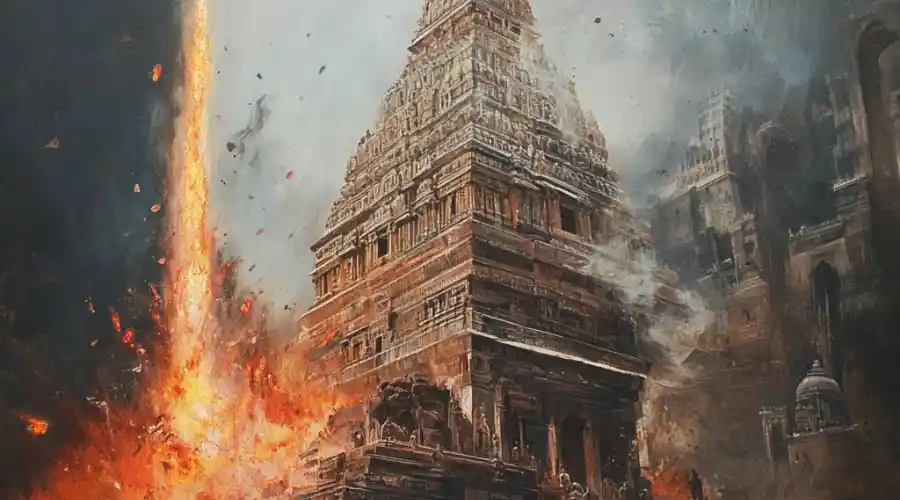Tranquil Beauty of Guruvayur Temple: A Family’s Sacred Visit
Embark on a serene pilgrimage to the Guruvayur Temple, where the divine presence of Lord Krishna captivates hearts.

The Baidyanath Temple, located in the sacred town of Deoghar in Jharkhand, is one of the most celebrated pilgrimage sites in India. Devotees recognize it as one of the twelve Jyotirlingas—the holiest abodes of Lord Shiva, worshipped across the subcontinent. Every year, millions of pilgrims travel to this temple with prayers for healing, peace, and spiritual liberation.
Set against the tranquil landscape of Deoghar, the Baidyanath Temple radiates divine energy. Its name, “Baidyanath,” meaning Lord of Physicians, emphasizes its role as a sacred center of healing. Believers hold that Lord Shiva not only blesses devotees with liberation (moksha) but also grants them strength, health, and relief from suffering. The temple embodies a unique blend of mythology, devotion, and spirituality, making it an unforgettable destination on India’s map of sacred sites.
The Baidyanath Temple’s significance arises from its status as one of the twelve Jyotirlingas mentioned in the Shiv Purana. Each Jyotirlinga manifests a different aspect of Shiva’s power, and Baidyanath is renowned for its healing energy. Pilgrims often call it the place where body, mind, and soul meet divine grace.
References to Baidyanath appear in ancient scriptures like the Skanda Purana, Padma Purana, and Shiv Purana. These texts describe the temple as a gateway to salvation. Unlike other shrines that focus primarily on liberation after death, Baidyanath emphasizes well-being during life itself. That dual blessing—of healing and salvation—makes the temple extraordinary.
Although the temple’s exact origin remains uncertain, historical evidence suggests that it has stood for centuries. Various rulers of Bihar and Jharkhand patronized it, offering land grants and donations for its upkeep. Over time, Baidyanath Temple grew into a central hub of spiritual energy, where saints, yogis, and seekers gathered in search of enlightenment.

The temple’s aura deepens when one listens to its legends. These stories, passed through generations, add layers of meaning to every stone and ritual.
Among the most famous legends is the story of Ravana, the mighty king of Lanka. Known both as a fearsome ruler and a devout worshipper of Lord Shiva, Ravana undertook severe penance to please Mahadev. He offered his own ten heads as sacrifice, one after another, to demonstrate his devotion. Impressed by this act, Lord Shiva restored his heads and granted him a boon.
Ravana requested a powerful Shivlinga that would ensure his invincibility. Lord Shiva agreed but warned that the Shivlinga must never touch the ground until it reached Lanka. Ravana carried it with great care. However, the gods feared that his growing strength would threaten cosmic balance. Lord Vishnu devised a plan and sent Lord Ganesha in disguise to intercept him.
As Ravana reached Deoghar, fatigue overcame him. He asked a Brahmin boy, who was none other than Ganesha in disguise, to hold the Shivlinga. The boy agreed but placed it firmly on the ground. When Ravana returned, he tried with all his might to lift it, but the Shivlinga remained rooted. His failure marked the divine establishment of the Baidyanath Jyotirlinga at Deoghar, where it continues to be worshipped.
Another legend emphasizes the temple’s connection with healing. When Ravana injured himself during penance, Shiva appeared as a divine physician—Vaidya—to heal his wounds. From then on, devotees believed that Shiva at Baidyanath blesses people with health and cures. Hence, pilgrims flock to the temple seeking both physical and spiritual wellness.
Local traditions also link the temple with Goddess Sita. It is said that she offered prayers here for Lord Rama’s safety during their years of exile. This association further elevates the shrine’s sacredness, as it connects directly with the epic Ramayana.
The Baidyanath Temple complex is not only a spiritual landmark but also an architectural masterpiece. Built in the Nagara style, it features a towering shikhara (spire) that rises majestically above the sanctum. Intricate carvings adorn the walls, depicting deities, mythological episodes, and sacred motifs.
The central sanctum enshrines the ancient Shivlinga, believed to be self-manifested (Swayambhu). Surrounding the main shrine are 21 other temples dedicated to various deities such as Parvati, Ganesha, Kali, and Vishnu. Together, they form a vibrant spiritual universe within the complex.
The design of the temple reflects deep symbolism. The vertical rise of the shikhara signifies the soul’s aspiration to unite with the divine, while the sanctum’s enclosed darkness represents the womb of creation. As devotees step inside, they move symbolically from darkness toward light, ignorance toward knowledge, and bondage toward liberation.
Every day at Baidyanath Temple, rituals unfold with precision and devotion. Priests chant Vedic mantras, perform abhishekas (ritual baths of the Shivlinga), and offer milk, honey, and bel leaves. Devotees believe these offerings cool Shiva’s fiery energy and purify the devotee’s soul.
The temple follows a strict schedule of worship, beginning with the early morning Mangala Aarti and continuing with rituals throughout the day. Each ritual reinforces the intimate bond between the devotee and the divine. Unlike many temples, Baidyanath allows pilgrims to touch the Shivlinga directly, heightening the sense of closeness with Lord Shiva.
During the sacred month of Shravan (July–August), the temple witnesses one of the largest gatherings of Shiva devotees in the world. Pilgrims known as Kanwariyas walk barefoot for hundreds of kilometers, carrying holy water from the Ganges at Sultanganj to offer at Baidyanath. The sight of endless streams of saffron-clad devotees chanting “Bol Bam” creates a spiritual atmosphere unlike any other.
Around the temple lie several sacred ponds and water bodies, collectively known as Teerthas. Pilgrims believe that bathing in these waters purifies sins and prepares them for divine worship. Each Teertha carries its own legend. For instance, Chandrakupa Teertha is said to have been created by Lord Shiva himself for devotees to cleanse their karmic debts.
These water bodies transform the temple into not just a shrine but an ecosystem of sacred geography, where nature and divinity merge seamlessly.
Baidyanath Temple comes alive during festivals, especially Mahashivaratri. On this auspicious night, devotees keep vigil, singing hymns and chanting “Om Namah Shivaya” until dawn. The temple glows with oil lamps, and the air vibrates with collective devotion.
During Shravan Mela, the entire town of Deoghar transforms into a sea of pilgrims. Streets fill with chanting, music, and the rhythmic beating of drums as millions walk toward the temple. For devotees, this journey is not merely physical but also symbolic of their spiritual progress.
Other celebrations such as Diwali, Navaratri, and Bhaidooj also attract devotees, but none rival the grandeur of Shravan and Mahashivaratri.
For countless pilgrims, visiting Baidyanath Temple is more than ritual worship; it is a quest for healing. Many arrive with physical ailments, emotional burdens, or spiritual restlessness. The temple, with its legends of Shiva as a healer, offers them hope. Stories abound of devotees who found relief from chronic illnesses or discovered peace of mind after offering prayers here.
Faith in Baidyanath’s healing powers transcends generations. Families often visit together, carrying forward traditions of devotion. In this way, the temple continues to act as a sanctuary of both faith and medicine, where prayers and remedies intertwine.
The Baidyanath Temple is not just a religious site but also a cultural anchor for the region. Its rituals, festivals, and traditions influence the social fabric of Deoghar and neighboring states. Local artisans craft souvenirs and offerings, while musicians and priests preserve devotional hymns that have been sung here for centuries.
The temple also attracts scholars of history, architecture, and religion, making it a center for academic exploration. Through its legends, practices, and cultural expressions, Baidyanath Temple contributes richly to India’s spiritual heritage.
For modern pilgrims, a journey to Baidyanath Temple remains both accessible and rewarding. Deoghar is well-connected by rail and road, with accommodations ranging from simple lodges to comfortable hotels. The temple opens early in the morning, and devotees often line up hours in advance for darshan (divine sight).
Travelers are encouraged to participate in the rituals, especially the offering of jalabhishek—pouring holy water over the Shivlinga. Many combine their trip with visits to nearby attractions such as Tapovan Caves, Naulakha Mandir, and Trikut Pahar, enhancing both the spiritual and cultural experience.
The Baidyanath Temple is far more than an ancient structure or a point on a map. It is a living embodiment of India’s rich spiritual heritage. Its legends of Ravana’s devotion, Shiva’s healing powers, and Sita’s prayers elevate it beyond mere history into the realm of eternal myth.
Every ritual, festival, and prayer at Baidyanath reinforces the timeless bond between humanity and divinity. Devotees leave not only with blessings but also with renewed strength, inner peace, and a deeper sense of connection to the sacred.
As centuries pass, the temple continues to stand as a beacon of faith, healing, and devotion—a reminder that the journey to Baidyanath is, indeed, a journey of the soul.
A curated list of the most popular travel packages based on different destinations.
Embark on a serene pilgrimage to the Guruvayur Temple, where the divine presence of Lord Krishna captivates hearts.
Copyright 2025 Medibliss Transactions Pvt ltd | All Right Reserved.
Accepted Payment Methods :